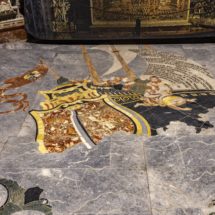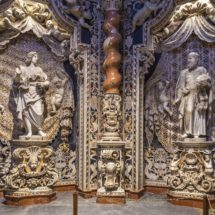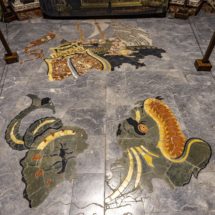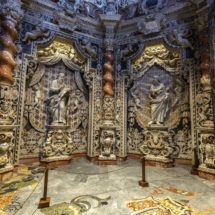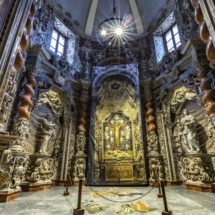Giovanni Roano was appointed Archbishop of Monreale in 1673, and remained there until 1703.
He has been one of the most enlightened bishops; he concretely promoted art and the artists.
He had the “Chapel of the Santissimo Crocifisso” built to place there the wooden crucifix which, according to an ancient tradition, was a gift from Guglielmo II.
The chapel, designed in 1686 by the Capuchin Fra Giovanni da Monreale, was then built under the guidance of the Jesuit architect Angelo Italia, who replaced him it in 1688, giving life to a true masterpiece of Sicilian Baroque, incredibly luxuriant for its bright polychromy of mixed marbles and the exceptional inlaid decorations that evoke a world of birds, monsters and cherubs on the walls. Thus, to the splendor of the mosaics of the Cathedral of Monreale is added the one of the mixed marbles, which, suitably dislocated, do not create a style conflict, allowing the coexistence of two fundamental artistic moments of the island in a single grandiose monument.
The structure of the Chapel is an irregular hexagon, surmounted by a dome, on which are inserted an entrance area and a rectangular apse covered by a barrel vault. On the sides of the apse there are two openings that, on the right, allow access to the sacristy and, on the left, to the small bell tower. The entrance portal is surmounted by a bas-relief with the figure of St. Giovannino, while the outer frame is composed of two pilasters, almost entirely covered by high plinths, on which stand the statues symbols of Faith and Hope
The inlay of the door jamb presents, among the symmetrical decorative elements, the intertwining of sacred and profane motifs: mythological beings, dragons, monstrous snakes and animals. The gilded brass doors that complete the portal are the work of Gaetano Signorello from Palermo.
The spiritual and architectural center of the complex is the Crucifix, which is placed on the wall behind the altar, on the visual axis of those who enter the chapel.
The fifteenth-century Crucifix is a late example of international Gothic of Nordic derivation to be ascribed to a Spanish sculptor of Valencian-Andalusian culture. Christ, contracted in an expression of pain, is nailed to the tree of Jesse which rises on his image, life-size. The branches of the tree cover the entire surface of the niche and host medallions with half figures in relief depicting the kings of Israel in light marble, with crowns, metal scepters and ribbons engraved with their names. In the center, above the head of Christ, is the bust of the Mother of God.
The sculptures have scrolls in their hands and are surmounted by cartouches, all with inscriptions taken from the Bible and with reference to the passion and death of Christ.
